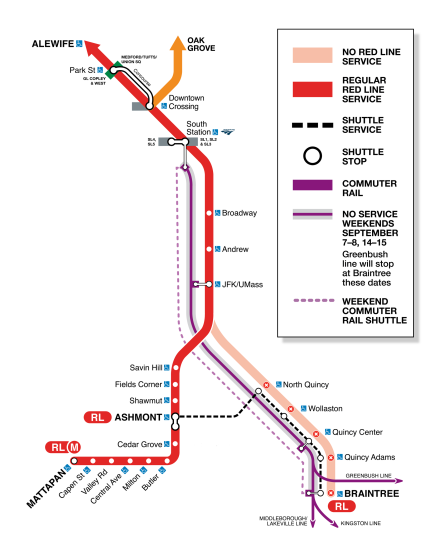Friday marks the start of a three-week-long shutdown of the Red Line’s Braintree branch from JFK/UMass to Braintree.
Regular service will resume Sept. 30.
“That’s 18 miles of track when you consider both directions of travel,” MBTA General Manager Phillip Eng told GBH’s Morning Edition. “What we’re replacing is significant amounts of that track infrastructure, the rail, the ties. And then we’ll be doing what we call resurfacing, where we’re bringing the track infrastructure to the grades that need to be allow us to run at the speeds that we plan to.”
Eng said he hopes portions of the track will be in good enough shape to allow trains to run at 50 mph. Prior to the shutdown the Braintree line was running as slow as 10 mph in some sections, with 20 slow zones. Eng said the agency is working to eliminate all of them.
“A lot of work going on. But our riders deserve it,” he said. “They’ve been waiting a long time for this. And I know as much as this diversion requires people to find alternative means, which we’re providing, they will have a much better commute in the future, long term.”

In the meantime, riders will have to rely on shuttle buses, which will take a longer path. They will follow the Red Line’s usual route from Braintree to North Quincy, then travel to Ashmont Station in Dorchester, where people can board the other branch of the Red Line.
Riders can also take the Commuter Rail, which will be running from Braintree to South Station every day of the shutdown except two weekends: Sept. 7-8 and 14-15.
“That’s because we’d be doing a lot of movement with the rail placement,” Eng said. “When we’re swinging rail on the Red Line, we don’t want to potentially fail service. So out of an abundance of caution, those weekends will be running shuttle buses through that whole corridor up to South Station.”
Eng said he hopes people will rely on the Commuter Rail when it’s available.
“We’ve lengthened the trains, we have double-stacked cars, and the ability to carry more people through that corridor. The trains will be running 7 to 8 minutes.”
This shutdown is part of a long list of network-wide temporary closures to deal with maintenance backlogs, especially in track grading.
Hopefully, riders can except fewer diversions in 2025, Eng said. There will still be some shutdowns, he noted, but the agency is looking at running trains on a single track while maintaining the other.
“What we are looking at, we will put out and share with the public, is how do we do maintenance, how do we do corrective repairs?” Eng said. “We have a lot of work still to do. We have signal work. We have power work. We have station work. But that doesn’t mean that we can’t find different ways.”







